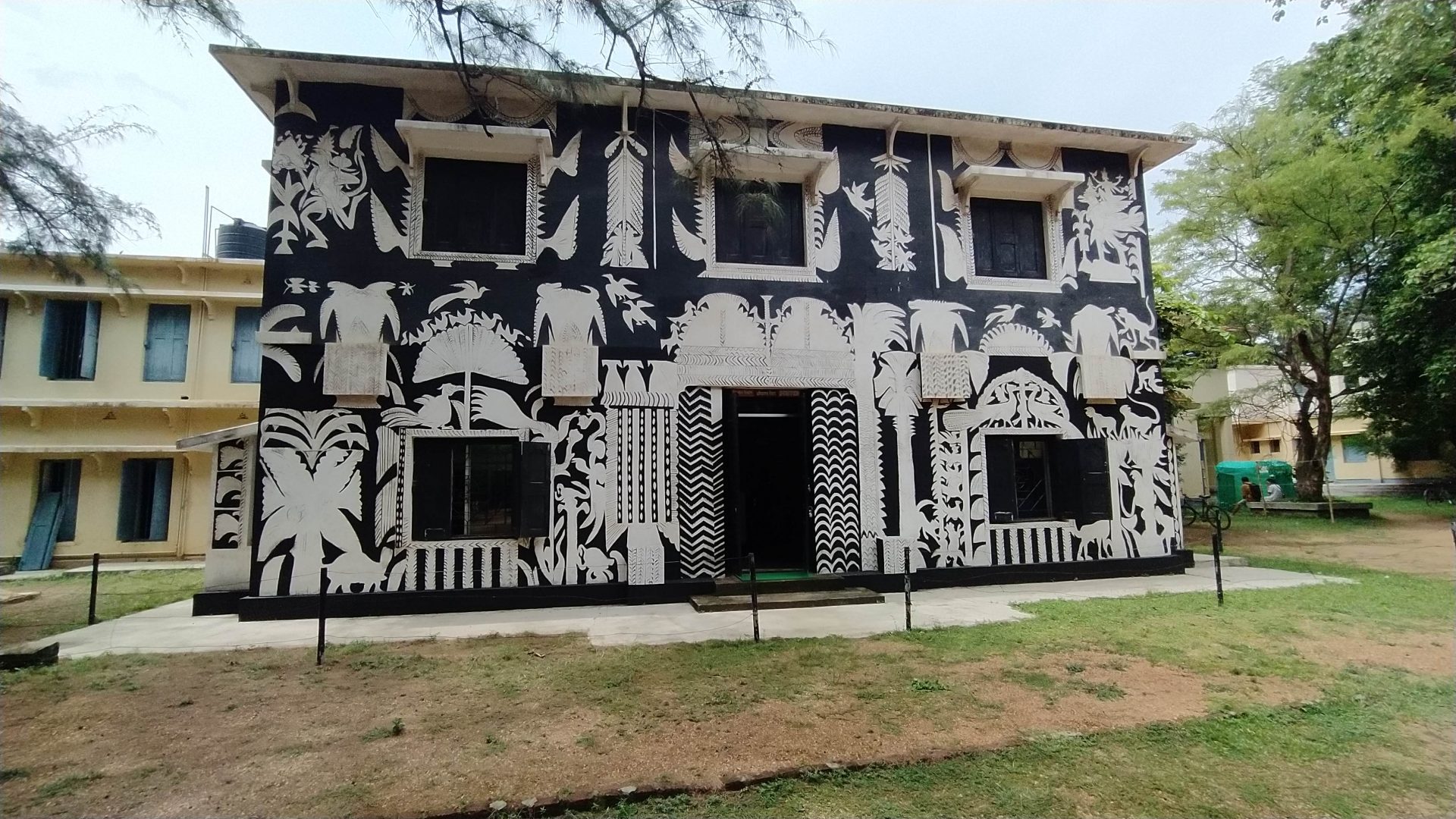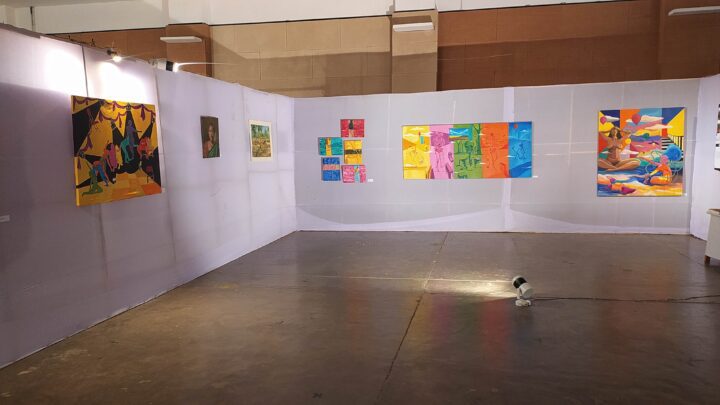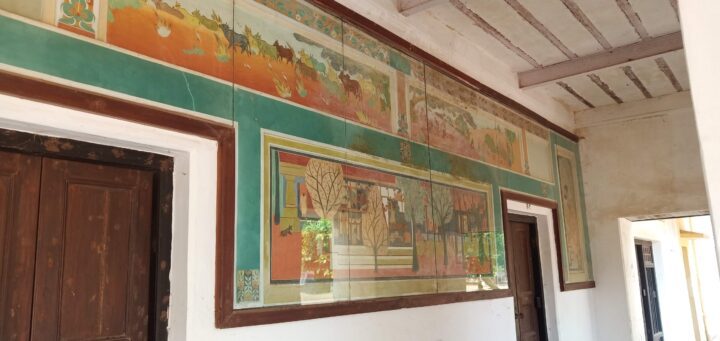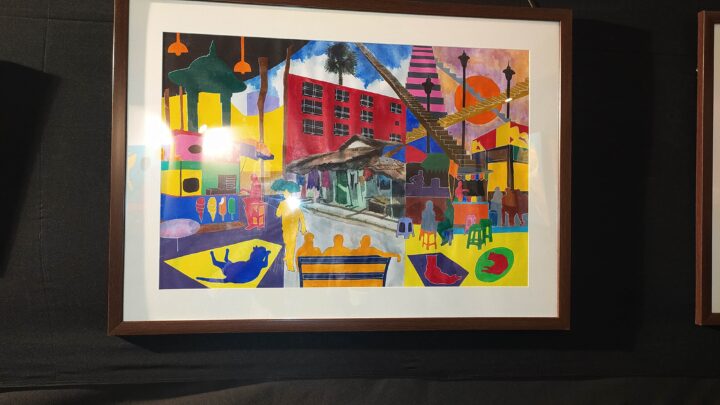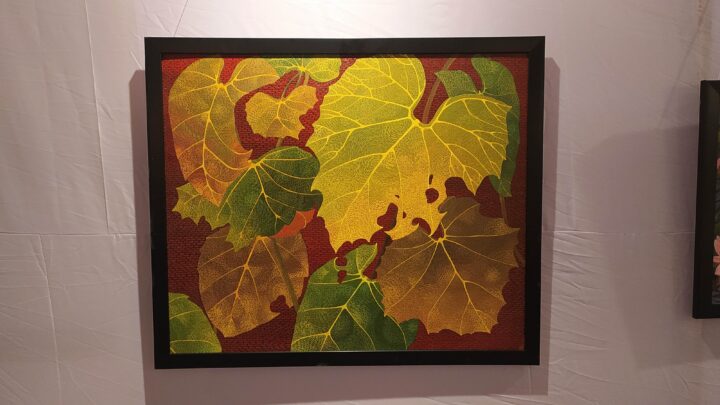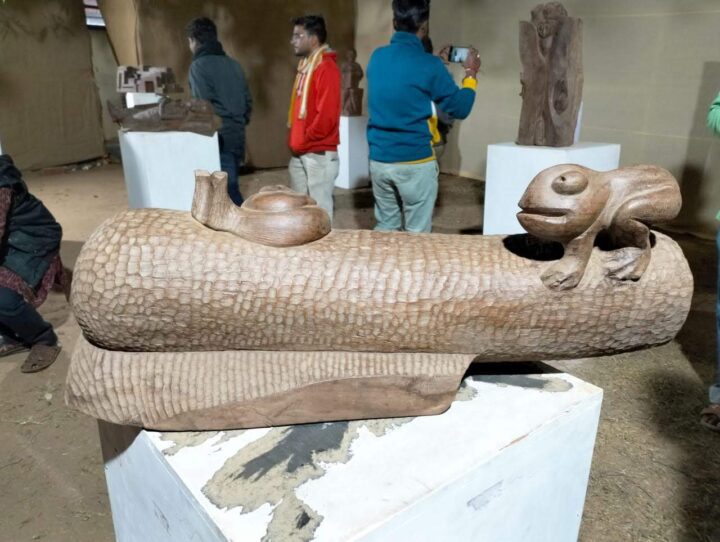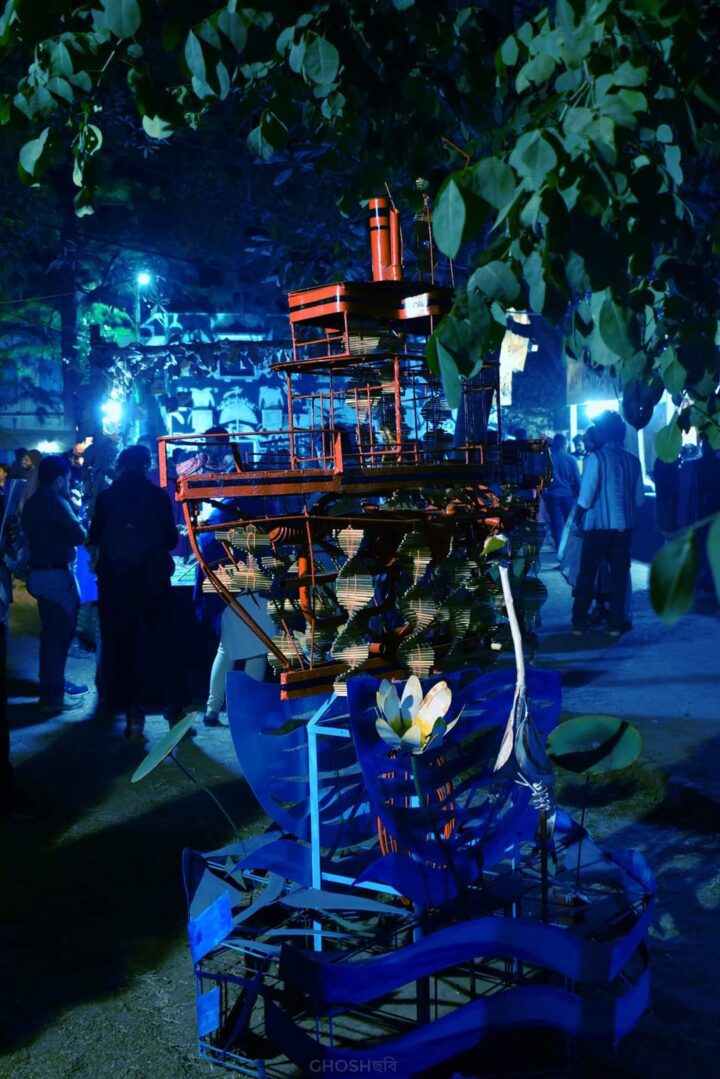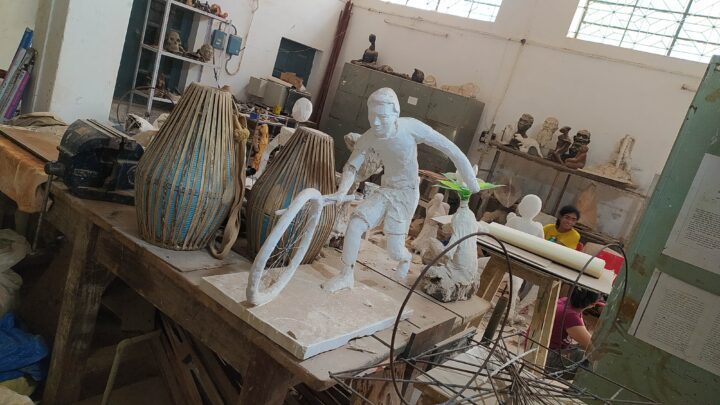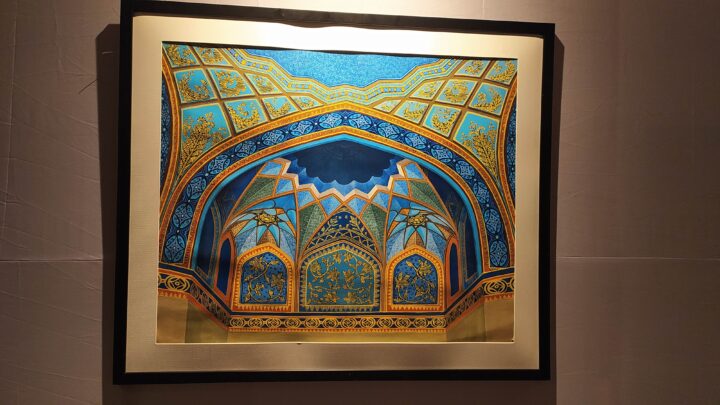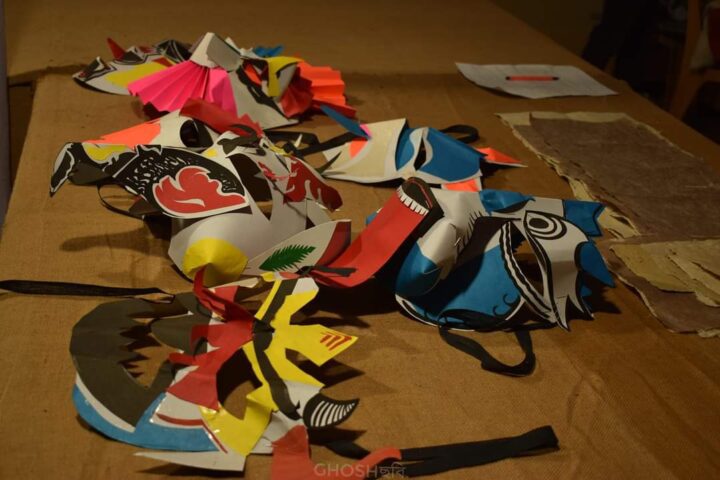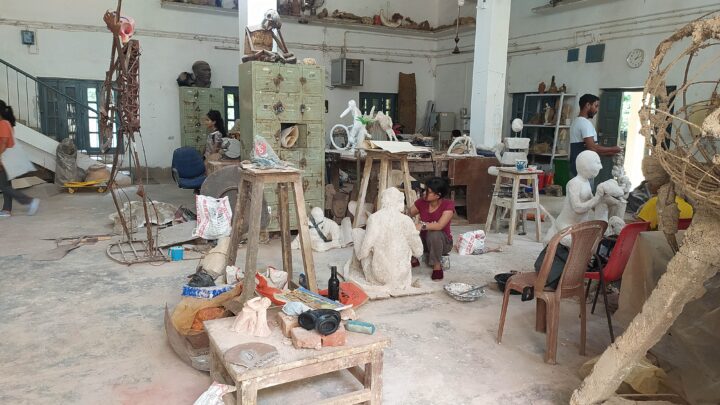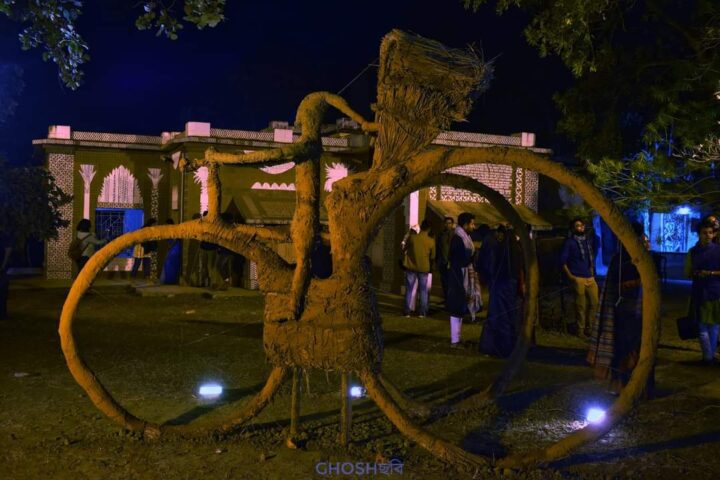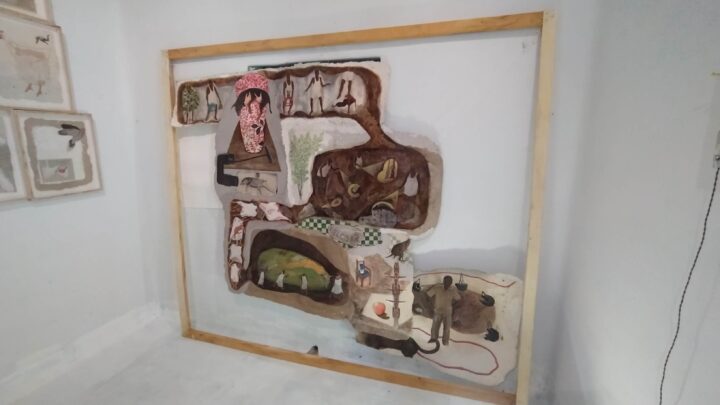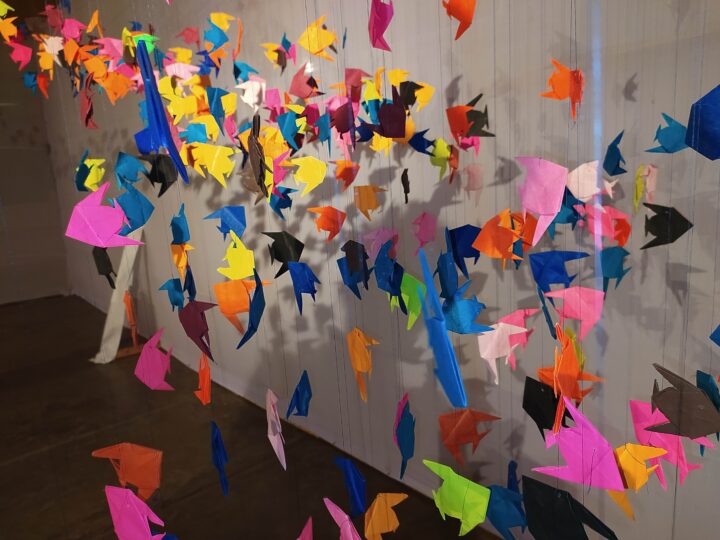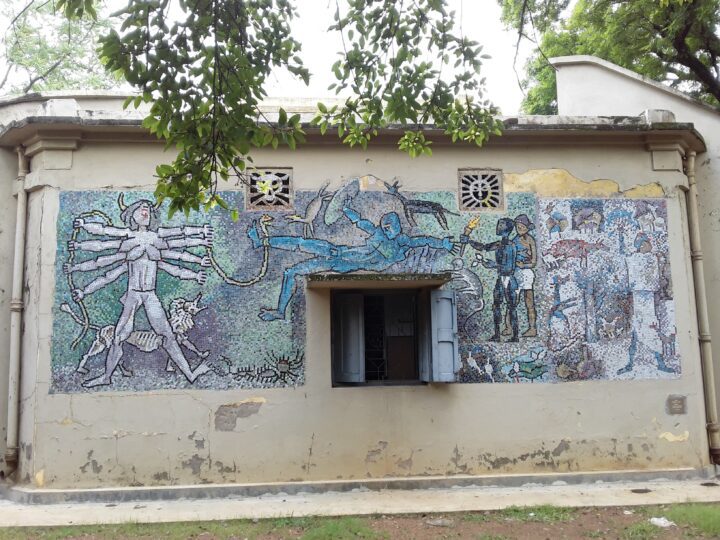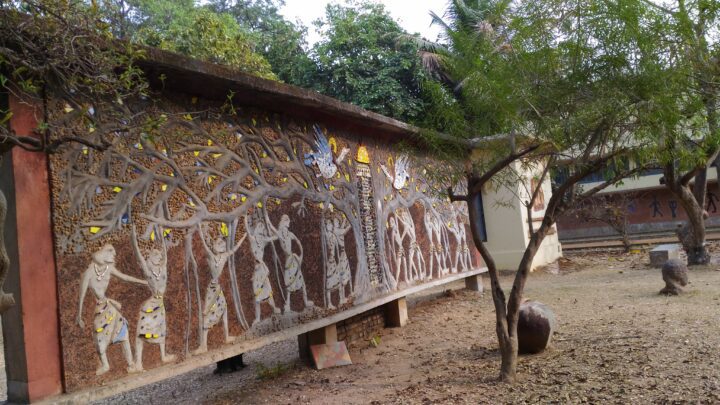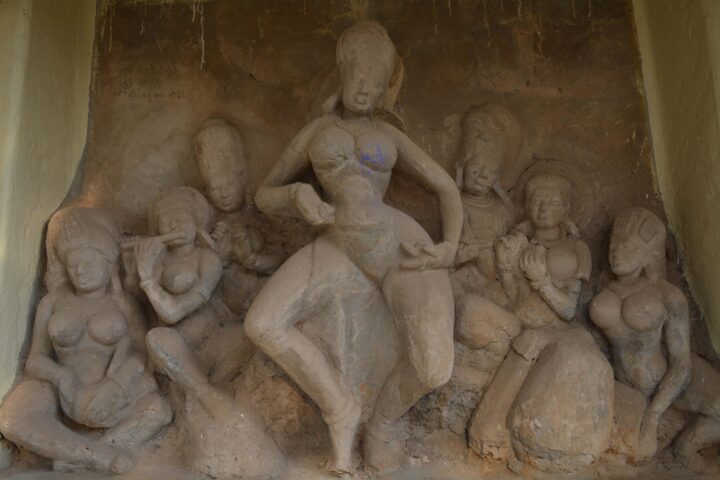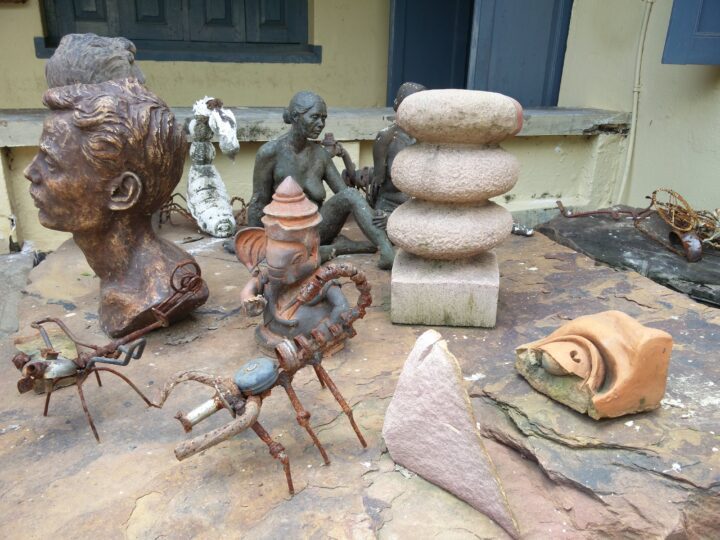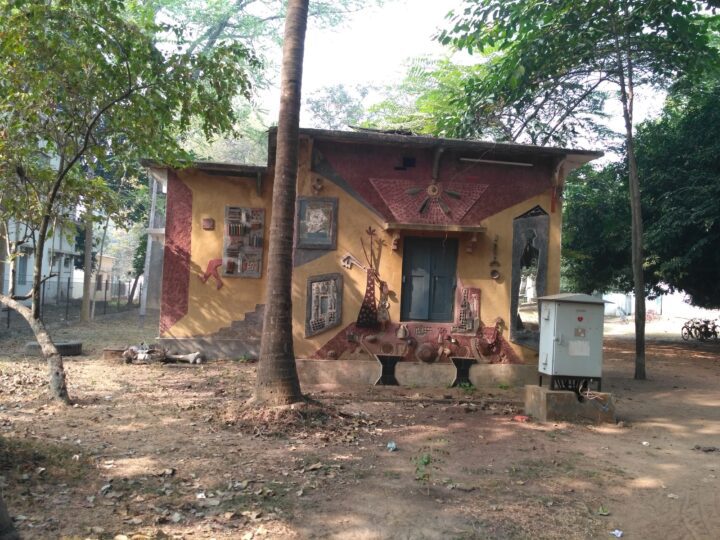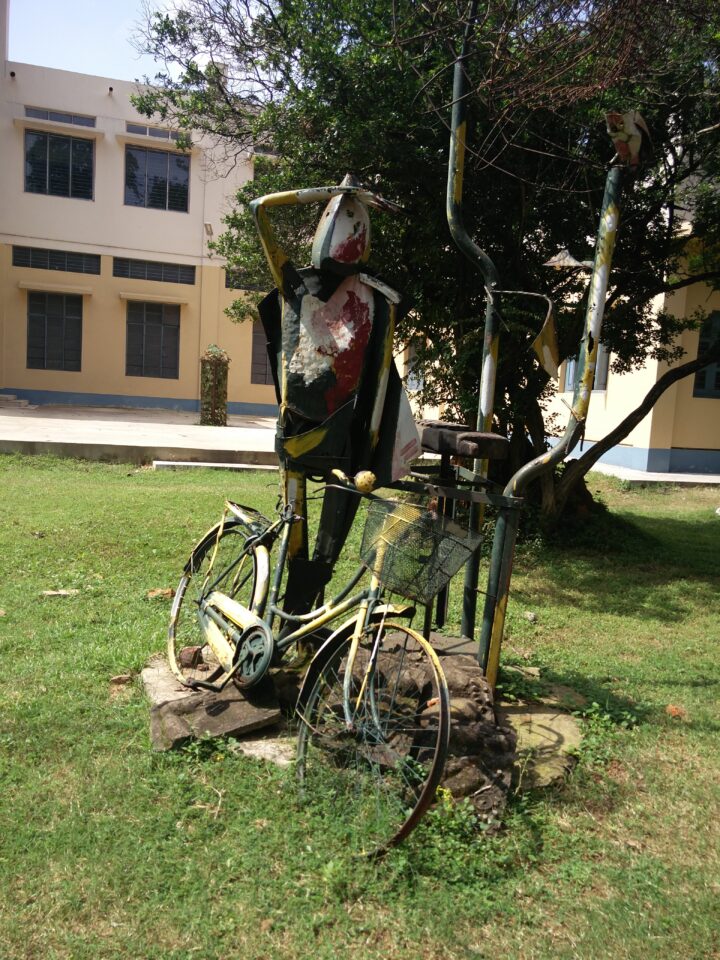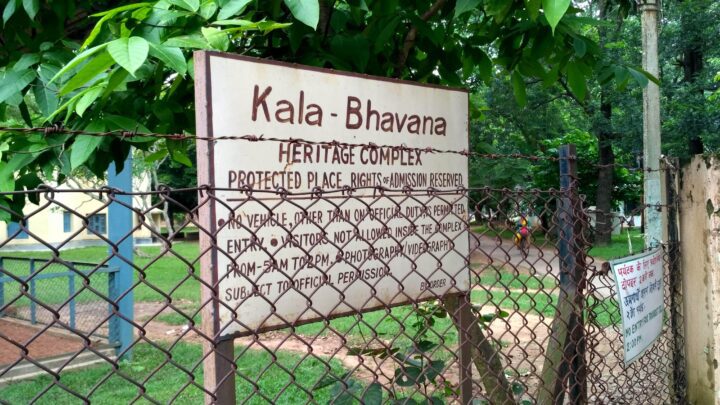Kala Bhavana is renowned for its outstanding contribution to the practice and research of visual arts in India. This institution played a vital role in shaping the culture-specific modernism movement initiated by Rabindranath Tagore and carried forward by Nandalal Bose, Benodebehari Mukhopadhyay, Ramkinkar Baij, and their contemporaries. Over the years, Kala Bhavana has provided a valuable direction to individual art activities in contemporary social space, with numerous distinguished artists and scholars keeping the tradition alive through their personal visual experiences, fresh exposure, and openness to experimentation.
Kala Bhavana – Shantiniketan’s Institute of Fine Arts College
Kala Bhavana’s academic programme is broad and diverse, introducing students to a vast array of techniques and art forms backed by an in-depth knowledge of art history. The studio practice, lectures, discussions, and exhibitions create a vibrant artistic atmosphere where students have ample opportunities to refine their individual sensibilities and future prospects.
Currently, Kala Bhavana offers six major streams of study, including Painting, Graphic Art (Printmaking), Design (Ceramic & Glass), Design (Textile), History of Art, and Sculpture. The institution offers a variety of courses, including Certificate, Diploma, B.F.A. (Honours), M.F.A., Advanced Diploma, Foreign Casual Course, Casual Course for Indian, and Bridge Course in History of Art. It is a distinguished centre for visual art practice and research, renowned for its rich contributions to contemporary social space. Its academic program is comprehensive and diverse, providing students with a vast array of artistic techniques and knowledge of art history.
Photo Gallery
Revolutionizing Art Education in India: The Story of Kala Bhavana’s Founding and Early Years
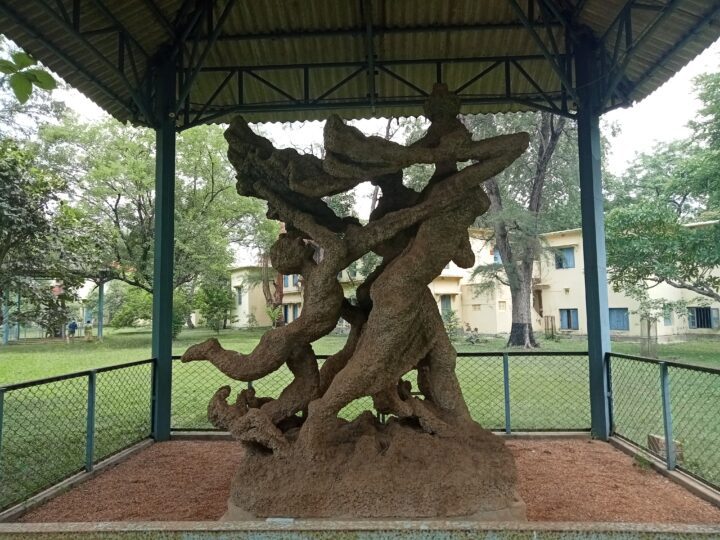
Kala Bhavana, which celebrated its centenary in 2019, was established in 1919. Although the exact date of its foundation is uncertain, it began teaching music and art when it first started functioning. By 1933, the two streams were separated into two different schools: Kala Bhavana and Sangit Bhavana.
Noted painter Nandalal Bose, a disciple of Abanindranath Tagore, founder of the Bengal school of art movement, was invited by Tagore to become the first principal of Kala Bhavana upon its establishment in 1919. Over time, stalwarts such as Benode Behari Mukherjee and Ramkinkar Baij became associated with the college, giving not just a new direction to the institution but also to modern Indian painting. In Santiniketan, the ideas of Rabindranath Tagore on art and teaching continued for a long time as a monumental model. Subsequently, they developed in the art arena of Santiniketan, the three pillars of ideas – Nandalal Bose, Benode Behari Mukherjee, and Ramkinkar Baij. Together, they raised Santiniketan to a level of unique eminence in the field of modern art in twentieth-century India.
In 1997, R. Siva Kumar, a leading art historian, curated an exhibition, Santiniketan: The Making of a Contextual Modernism, at the National Gallery of Modern Art. The exhibition brought together about a hundred works of the four modern Indian artists, namely Nandalal Bose, Rabindranath Tagore, Ram Kinker Baij, and Benode Behari Mukherjee, placing the Santiniketan art movement into focus. R. Siva Kumar argued that the “Santiniketan artists did not believe that to be indigenous one has to be historicist either in theme or in style, and similarly to be modern one has to adopt a particular trans-national formal language or technique. Modernism was to them neither a style nor a form of internationalism. It was critical re-engagement with the foundational aspects of art necessitated by changes in one’s unique historical position.”
Dinkar Kaushik, as the principal of Kala Bhavana, reshaped it for contemporary art practices. He invited prominent artists, such as sculptor Sarbari Roy Choudhury, Ajit Chakraborty, graphic artist Somnath Hore, and painters Sanat Kar and Lalu Prasad Shaw, to join Kala Bhavana as teachers. Among the many things he did to revolutionize the institution was to hold Nandan Mela, which celebrates the birth anniversary of Nandalal Bose on 1-2 December. At Nandan Mela, students participate in various activities, including art stalls put up by the Painting, Sculpture, Ceramics, Graphics, Design, and Art History Departments. These stalls offer affordable artworks made by the students and teachers, ranging from calendars to craft items, diaries, stationery, fashion jewelry, paintings, prints, saras (clay plates), and ceramics, wood, and metal sculptures.
Transforming Lives through Art and Design: The Legacy of Kala Bhavana College
Kala Bhavana houses an art gallery called Nandan that exhibits sculptures, frescoes, and murals. In the 1960s, the Birla and Goenka families built two girls’ hostels named after them. Kala Bhavana has an impressive collection of 17,000 original artworks by eminent Indian and Far-Eastern masters. The institution is seeking external support to preserve and display these artworks.
Nandalal Bose became the first principal of Kala Bhavana in 1923 and was followed by other renowned artists such as Benode Behari Mukherjee, Ramkinkar Baij, K. G. Subramanyan, Dinkar Kaushik, R. Siva Kumar, Somnath Hore, and Jogen Chowdhury. Other notable figures who made their mark in the art arena of Santiniketan include Gouri Bhanja, Jamuna Sen, Sankho Chaudhuri, and Sanat Kar.
Kala Bhavana offers a Bachelor of Fine Arts degree, a Master of Fine Arts degree, as well as certificate degrees in painting, sculpture, mural painting, printmaking, design (textiles/ceramics), and art history.
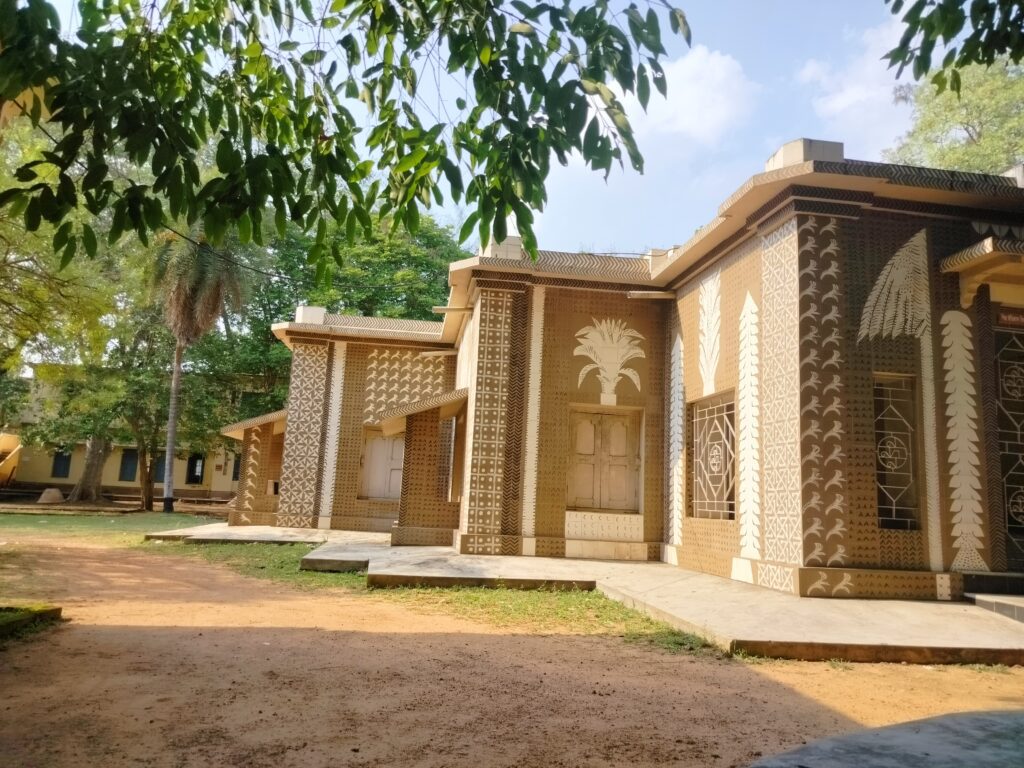
From Nandalal Bose to Satyajit Ray: The Legends Who Made Kala Bhavan a Household Name
- Nandalal Bose, a renowned artist and teacher, was entrusted with the task of embellishing the original copy of the Constitution of India. He enlisted the help of several of his students, including Bani Patel, Gauri Bhanja, Jamuna Sen, Amala Sarkar, Sumitra Narayan, Vinayak Masoji, Dinanath Bhargava, Kripal Singh Shekhawat, Jagdish Mittal, and others. The students were required to illustrate 34-inch borders on 300-odd pages with patterns from different historical ages of the subcontinent. The document was adopted on 26 January 1950. Dinanath Bhargava was also given the responsibility of adapting the design of the national emblem. Beohar Rammanohar Sinha illustrated the preamble and certain other pages. It is a matter of pride that artists from Kala Bhavana embellished this prestigious document.
In 2011, to commemorate Rabindranath Tagore’s 150th birth anniversary, Rabindra Chitravali was released. This four-volume set covered the painting oeuvre of masters consisting of 1,600 paintings from Rabindra Bhavana (another institution of the university) and Kala Bhavana collection, along with 200 paintings from other institutions across India.
- Satyajit Ray, the legendary filmmaker, studied at Kala Bhavana in 1940-1941 under the guidance of Benode Behari Mukherjee. He later made a notable documentary on his teacher, The Inner Eye (1972). He had previously made a 54-minute black-and-white documentary, Rabindranath Tagore, on the life of the poet on the occasion of his birth centenary. The film won the President’s Gold Medal Award, New Delhi, 1961 and the Golden Seal, Locarno, 1961.
- Ritwik Ghatak, another renowned filmmaker, created an incomplete documentary on sculptor Ramkinkar Baij called Ramkinkar. He started working on the film in 1975, but it remained unfinished due to his death.
- Santiniketan is home to nine original ink brush works of Xu Beihong, one of the pioneers of Chinese modern art. He painted these artworks during his visit to Santiniketan in 1939-40. His son, Xufangfang, visited in August 2019 and stated that he received inspiration from the creative environment at Visva Bharati.
In recent years, Kala Bhavana has continued to innovate and adapt to the changing landscape of contemporary art. The institution’s focus on integrating traditional art forms with contemporary techniques has made it a hub for experimental and interdisciplinary work. Students and faculty are encouraged to explore a wide range of media and styles, from painting and sculpture to video and digital art.
Kala Bhavana has also been instrumental in preserving and promoting Indian art and culture through its extensive collection of art works and manuscripts. The institution’s archive includes rare and valuable works by some of the most celebrated artists in India, providing a unique resource for researchers and scholars.
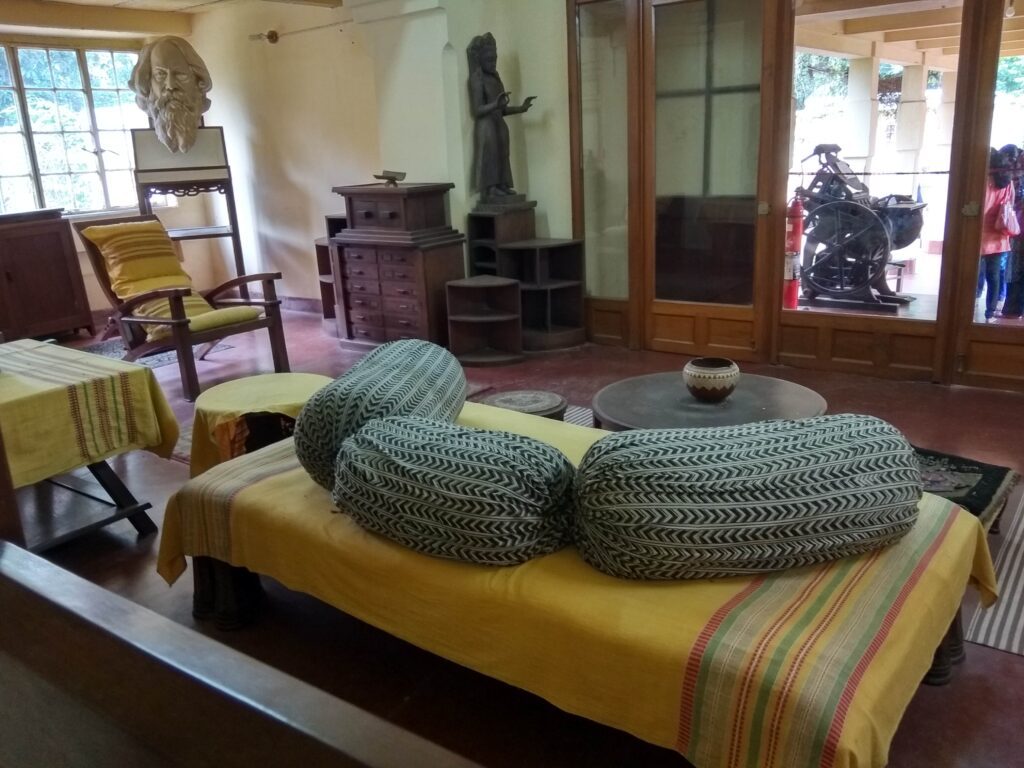
ALUMNI
- Sculptors
Ramkinkar Baij, one of India’s pioneering modern sculptors, was associated with Kala Bhavana as both a student and a teacher. He was awarded the Padma Bhushan and Padma Vibhushan awards.
Sankho Chaudhuri, sculptor and Padma Bhushan award winner, studied at Kala Bhavana. Sarbari Roy Choudhury, sculptor and artist, taught at Kala Bhavana and was awarded the Padma Shri. - Designers
Rekha Rodwittiya, artist and designer, graduated from Kala Bhavana. - Photographers
Nemai Ghosh, photographer and filmmaker, was associated with Satyajit Ray and worked as still photographer in many of Ray’s films. He studied at Kala Bhavana. - Filmmakers
Satyajit Ray, renowned filmmaker and Padma Bhushan and Padma Vibhushan award winner, studied at Kala Bhavana and later made a documentary on his teacher, Benode Behari Mukherjee.
Ritwik Ghatak, celebrated filmmaker, studied at Kala Bhavana and made a documentary on sculptor Ramkinkar Baij.
The list goes on, and it is clear that Kala Bhavana has nurtured some of India’s most talented artists and cultural figures.
Unlock Your Artistic Potential at Kala Bhavana, Santiniketan
Are you passionate about art and seeking a nurturing environment to explore your creativity? Look no further than Kala Bhavana, the esteemed Institute of Fine Arts nestled in the cultural haven of Santiniketan. Established in 1919 by the visionary Rabindranath Tagore, Kala Bhavana has been a beacon of artistic excellence, offering a spectrum of art courses to aspiring individuals.
Explore Diverse Art Disciplines
At Kala Bhavana, you have the opportunity to delve into various art forms, including:
- Painting: Unleash your imagination on canvas and express your innermost thoughts through colors and brushstrokes.
- Sculpture: Sculpt raw materials into magnificent forms and breathe life into your creations.
- Graphic Art: Dive into the world of printmaking and explore the intricacies of visual storytelling.
- Design: From textiles to ceramics, immerse yourself in the realm of design and blend aesthetics with functionality.
- Art History: Embark on a journey through time, unraveling the rich tapestry of art movements and cultural influences.
Whether you aspire to pursue a Bachelor of Fine Arts (BFA) or Master of Fine Arts (MFA) degree, Kala Bhavana offers comprehensive programs tailored to nurture your artistic talents. Additionally, certificate and diploma courses provide avenues for specialized training in mural painting, textiles, ceramics, and more.
Admission Eligibility, Criteria and Process
- Eligibility Criteria for MFA/Advanced Diploma Program:
- Candidates must have a minimum of 55% marks or equivalent grade in their BFA/DIP 4-year course.
- If results are pending, candidates must obtain their Confidential Reports (B.F.A./Diploma result) and submit them before admission.
- Direct Admission Privilege:
- Only First Class First in B.F.A. in each specialized subject from Kala Bhavana is entitled to direct admission in the MFA course.
- This privilege is non-transferable and not applicable to the Diploma Course.
- Admission Test for Diploma Holders:
- Diploma holders must appear for the admission test for the Advanced Diploma Course.
- Application Requirements for Painting in MFA (Hons.)/Advanced Diploma:
- Candidates must submit 5 photos (6”X4 inches) of their artwork attested by the respective principal along with the application form.
- Scanned copies sent via the internet will not be accepted.
- Selection Process:
- A primary selection of candidates for Painting in MFA (Hons.)/Advanced Diploma will be made based on submitted documents.
- Shortlisted candidates will be called for the Entrance Test, comprising practical, theoretical, and viva-voce components.
- The final list of selected candidates will be displayed at the Nandan office and on the university website, in addition to individual notifications.
Join Our Artistic Community
Immerse yourself in a vibrant artistic community at Kala Bhavana, where creativity knows no bounds. From esteemed faculty members to accomplished alumni, our campus pulsates with artistic energy and scholarly pursuits.
For inquiries and further information, please contact:
Adhyaksha (Principal), Kala-Bhavana
Visva-Bharati P.O. Santiniketan -731 235
District – Birbhum, West Bengal, India
Telephone: +91 3463 262 751 to 262 756 (6 lines), Extension – 313 / 374
Email: kalabhavana.mail@gmail.com
Unleash your creativity and embark on a transformative journey at Kala Bhavana, where art transcends boundaries and fosters personal and artistic growth.

